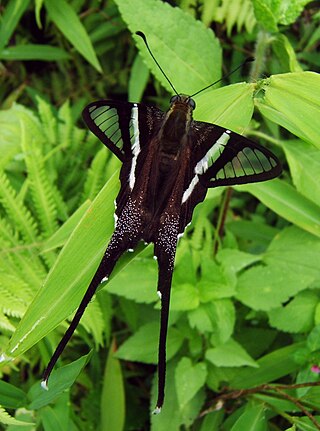
Lamproptera curius, the white dragontail, is a species of swallowtail butterfly native to parts of South Asia and Southeast Asia where it is common. It belongs to the dragontails genus, Lamproptera, of the swallowtail family, Papilionidae.

Graphium cloanthus, the glassy bluebottle, is a common, non-threatened tropical butterfly of the family Papilionidae.

Phragmatobia fuliginosa, the ruby tiger, is a moth of the family Erebidae.
Spectroreta is a monotypic moth genus belonging to subfamily Drepaninae erected by Warren in 1903. Its only species, Spectroreta hyalodisca, was described by George Hampson in 1896.

Platylesches galesa, the white-tail hopper or black hopper, is a butterfly of the family Hesperiidae. It is found in Transvaal, Mozambique and Zimbabwe. It is common in forest and woodland.
Chamanthedon amorpha is a moth of the family Sesiidae. It is found in Mozambique.
Chamanthedon leucocera is a moth of the family Sesiidae. It is known from Kenya and Malawi.
Chamanthedon leucopleura is a moth of the family Sesiidae. It is known from South Africa.
Chamanthedon tapeina is a moth of the family Sesiidae. It is known from South Africa.

Fascellina chromataria is a moth in the family Geometridae described by Francis Walker in 1860. It is found in Korea, Japan, Taiwan, China, India, Bhutan and Sri Lanka.

Acraea pentapolis, also known as the scarce tree-top acraea or eastern musanga acraea, is a butterfly in the family Nymphalidae. It is found in western and central Africa.

Deinodryinus velteni is an extinct species of Deinodryinus in the wasp family Dryinidae. The species is known solely from an Eocene fossil found in the Baltic region.

Eutelia geyeri is a moth of the family Noctuidae first described by Rudolf Felder and Alois Friedrich Rogenhofer in 1874. This species is found in India, Sri Lanka, China and Japan, as well as from Africa, where its presence had been reported from Lesotho and Seychelles.
Diptilon crassa is a moth of the subfamily Arctiinae. It was described by Hans Zerny in 1912. It is found in Colombia.
Diptilon hoffmannsi is a moth of the subfamily Arctiinae. It was described by Rothschild in 1911. It is found in Peru.
Episcepsis demonis is a moth of the family Erebidae. It was described by Herbert Druce in 1896. It is found in Panama and Peru.
Hyalaethea solomonis is a moth of the subfamily Arctiinae. It was described by George Hampson. It is found on the Solomon Islands.
Polygrammodes rufinalis is a moth in the family Crambidae. It is found in Venezuela.
Ulopeza denticulalis is a species of moth in the family Crambidae. It was described by George Hampson in 1912. It is found in South Africa.

Chaetaglaea tremula, the trembling sallow, is a moth in the family Noctuidae. It is found from southern Florida, through Louisiana and Mississippi west to eastern Texas.








